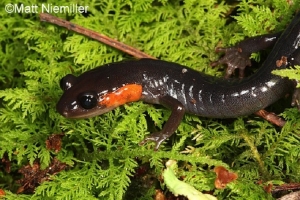Red-cheeked Salamander
The Red Cheeked Salamander, Plethodon jordani, is a species, also known as Jordan’s Salamander, that is found exclusively within the boundary of the Great Smoky Mountains National Park at higher elevations. It is also part of the Jordan’s Salamanders complex along with Northern Gray-cheeked (P. montanus) and Red-legged Salamander (P. shermani). These closely related salamanders often hybridize. A long (3.5 to 5.0 inches in length) slate gray to bluish-black salamander with reddish cheek patches. The belly is gray to black. No other colors or patterns occur on the body.
Similar Species: Northern Gray-cheeked Salamander has no red on its body. The Southern Appalachian Salamander has tiny white spots on the back and larger white spots on the sides.
Habitat: Found under moss, rocks, logs, and bark in cool, moist forests above 2500 feet, especially spruce-fir forests.
Diet: A variety of invertebrates, including spiders, moths, flies, beetles, aphids, and snails.
Breeding information: Very little data. Adults breed on land, and eggs are assumed to be laid in underground cavities, similar to other Plethodon species. Females probably brood the eggs, and hatchlings will emerge as miniature adults, as opposed to entering the larval stage.
Status in Tennessee: The Entire population occurs in the Great Smoky Mountains National Park, so it is protected from logging and farming operations.
Fun Facts:
- Named in honor of David Starr Jordan (1851-1931), respected ichthyologist and president of Stanford University.
Best places to see in Tennessee: Higher elevation spruce-fir forests of the Great Smoky Mountains National Park.

